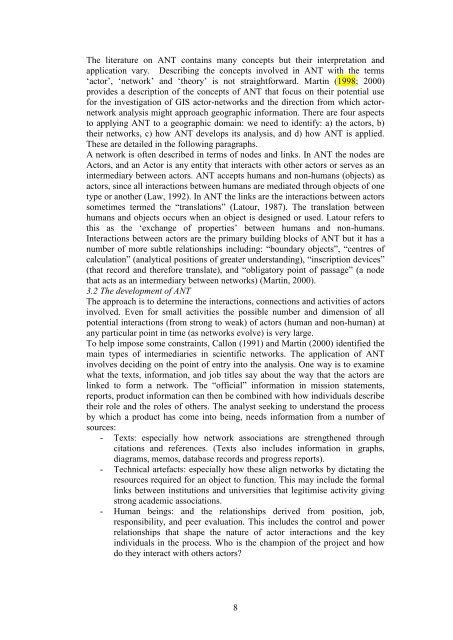Actor Network Theory - Leicester Research Archive - University of ...
Actor Network Theory - Leicester Research Archive - University of ...
Actor Network Theory - Leicester Research Archive - University of ...
You also want an ePaper? Increase the reach of your titles
YUMPU automatically turns print PDFs into web optimized ePapers that Google loves.
The literature on ANT contains many concepts but their interpretation and<br />
application vary. Describing the concepts involved in ANT with the terms<br />
‗actor‘, ‗network‘ and ‗theory‘ is not straightforward. Martin (1998; 2000)<br />
provides a description <strong>of</strong> the concepts <strong>of</strong> ANT that focus on their potential use<br />
for the investigation <strong>of</strong> GIS actor-networks and the direction from which actornetwork<br />
analysis might approach geographic information. There are four aspects<br />
to applying ANT to a geographic domain: we need to identify: a) the actors, b)<br />
their networks, c) how ANT develops its analysis, and d) how ANT is applied.<br />
These are detailed in the following paragraphs.<br />
A network is <strong>of</strong>ten described in terms <strong>of</strong> nodes and links. In ANT the nodes are<br />
<strong>Actor</strong>s, and an <strong>Actor</strong> is any entity that interacts with other actors or serves as an<br />
intermediary between actors. ANT accepts humans and non-humans (objects) as<br />
actors, since all interactions between humans are mediated through objects <strong>of</strong> one<br />
type or another (Law, 1992). In ANT the links are the interactions between actors<br />
sometimes termed the ―translations‖ (Latour, 1987). The translation between<br />
humans and objects occurs when an object is designed or used. Latour refers to<br />
this as the ‗exchange <strong>of</strong> properties‘ between humans and non-humans.<br />
Interactions between actors are the primary building blocks <strong>of</strong> ANT but it has a<br />
number <strong>of</strong> more subtle relationships including: ―boundary objects‖, ―centres <strong>of</strong><br />
calculation‖ (analytical positions <strong>of</strong> greater understanding), ―inscription devices‖<br />
(that record and therefore translate), and ―obligatory point <strong>of</strong> passage‖ (a node<br />
that acts as an intermediary between networks) (Martin, 2000).<br />
3.2 The development <strong>of</strong> ANT<br />
The approach is to determine the interactions, connections and activities <strong>of</strong> actors<br />
involved. Even for small activities the possible number and dimension <strong>of</strong> all<br />
potential interactions (from strong to weak) <strong>of</strong> actors (human and non-human) at<br />
any particular point in time (as networks evolve) is very large.<br />
To help impose some constraints, Callon (1991) and Martin (2000) identified the<br />
main types <strong>of</strong> intermediaries in scientific networks. The application <strong>of</strong> ANT<br />
involves deciding on the point <strong>of</strong> entry into the analysis. One way is to examine<br />
what the texts, information, and job titles say about the way that the actors are<br />
linked to form a network. The ―<strong>of</strong>ficial‖ information in mission statements,<br />
reports, product information can then be combined with how individuals describe<br />
their role and the roles <strong>of</strong> others. The analyst seeking to understand the process<br />
by which a product has come into being, needs information from a number <strong>of</strong><br />
sources:<br />
- Texts: especially how network associations are strengthened through<br />
citations and references. (Texts also includes information in graphs,<br />
diagrams, memos, database records and progress reports).<br />
- Technical artefacts: especially how these align networks by dictating the<br />
resources required for an object to function. This may include the formal<br />
links between institutions and universities that legitimise activity giving<br />
strong academic associations.<br />
- Human beings: and the relationships derived from position, job,<br />
responsibility, and peer evaluation. This includes the control and power<br />
relationships that shape the nature <strong>of</strong> actor interactions and the key<br />
individuals in the process. Who is the champion <strong>of</strong> the project and how<br />
do they interact with others actors?<br />
8














